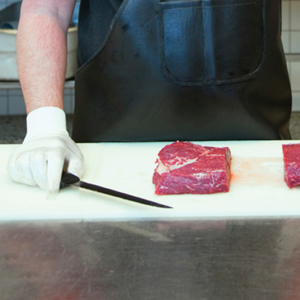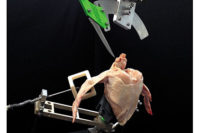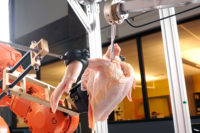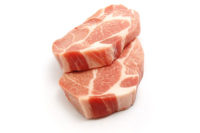
|
“The goal is to get to a ‘lot size of one,’ where everything is uniquely handled, which is very hard,” says Gary McMurray, chief of the Food Processing Technology Division at the Atlanta-based Georgia Tech Research Institute (GTRI).
Although robots and fixed automation systems have made inroads into other labor-heavy fields, they have remained largely absent from the meat and poultry industries due to their high cost and inability to reach human-level accuracy and flexibility. In addition, processing plants’ working conditions can be too harsh and fast for robots, the product is ever-changing — with different sizes and textures — and they can crash while “talking” to each other.
However, university laboratories such as GTRI are experimenting with practical applications for robots, and variations of product and directing blades.
“The old $2-million-dollar robots are $300,000 now, so it is actually worth the time to discuss real-world applications,” says Jerry Dyer, processing consultant and principle, Automation Planners Inc., of Gainesville, Ga.
Automating the inexact
The cutting and deboning process of chickens, in particular, offers up a whole host of challenges. The process begins after a chicken has been eviscerated and cleaned. During the cutting process, the bird’s wings, legs and thighs are removed, and the back is cut away from the breast but bones are not extracted. The remaining parts can either be packaged for consumer use, bulk-packed for delivery to other processors or sent to other parts of the plant for further processing.
Deboned products are created when meat is cut away from the bone and then trimmed and cleaned with traditional knives or scissors. Then, these parts can be packaged fresh or flash-frozen for consumers.
Breast deboning is certainly a technology all its own, with one basic problem that has plagued equipment manufacturers everywhere: the clavicle (pulley bone) is just too delicate to ever keep from breaking in today’s plants.
“Somewhere around 20 percent are broken before the bird ever gets to the deboning department, and removing the bone just takes a big chunk of expensive meat; so, automation is a slow go,” says Dyer. “The use of X-ray to find bones in the process later means we can find them, but there are just lots of them if that process is automated.”
The current cutting methods can also be inexact or wasteful, notes McMurray. Band saws, for one, can be off a little bit, so the end cut may not be the most optimal cut desired. Also pneumatic cutters, which are hand-held cutters that trim legs and thighs, can be overused by staff, he says, and slice off too much meat.
“Or with turkey, for example, the employees can leave too much fat on the carcass or trim too much meat instead of fat,” says McMurray. “But that loss is hard to quantify.”
Cutting intelligently
GTRI’s Intelligent Cutting and Deboning System aims to increase yield while decreasing the risk of bone fragments in the finished product. The project is using a unique 3D-vision system to model and evaluate each bird first before making precise cuts. Also a force feedback algorithm helps guide the robotic cutting arm to make cuts without hitting bone.
“The challenge is in trying to adapt the process to the bird, not the other way around,” says McMurray. “You’d much rather adapt an eviscerator spoon to a shorter bird than lengthen the bird, for example, because you know who will win that battle.”
Already, there are companies in Japan that X-ray the product first and then cut the product in the most optimal place.
“This is fairly pricey for good paybacks in most U.S. companies, but is the basis for lots of great methods to come from the idea,” says Dyer. “What is interesting about paybacks for such technology is that it is certainly not the labor cost involved, but rather the inability to find qualified labor that is willing to work in the processing environment.”
He notes that innovations in cutting and deboning, and other technological advances overall, have been stalled in the poultry industry for a few years as it has struggled due to high ingredient prices and oversupply.
“Thankfully the industry is returning to some level of sensible cost basis, and the quick return of innovation is everywhere,” says Dyer. Indeed, Dyer points out that for the first time in history, breast fillets, thigh fillets and wings were about the same price last year.
“This means there are lots of new thigh-deboning devices, with some really good potential to shift that process into a more in-line setup,” he says.





Report Abusive Comment